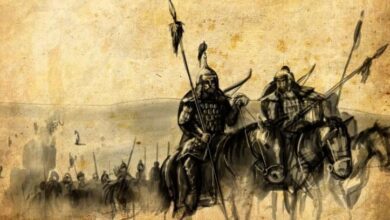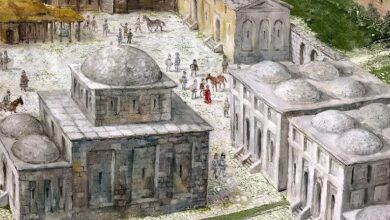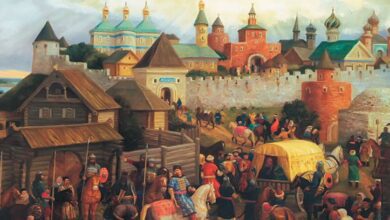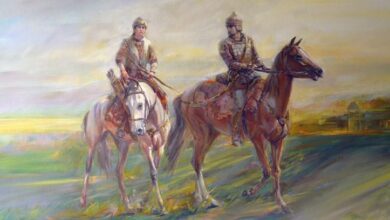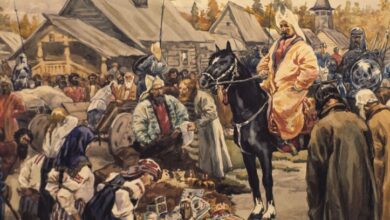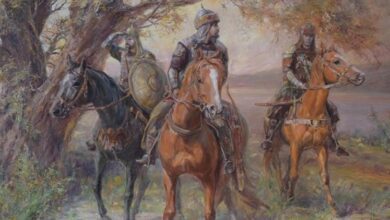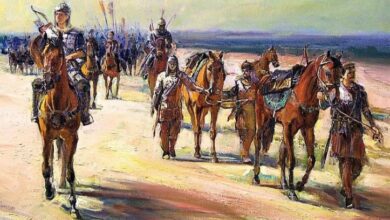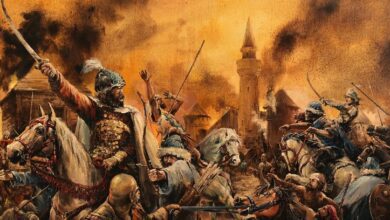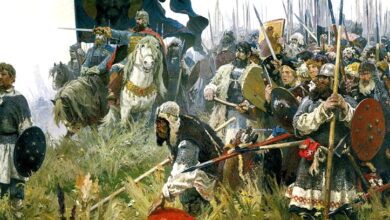
GThere are many cities with the name "Bulgar" ("Bolgar") in the world. Even on the Volga, there were several Bulgars. In the place of one - the Lower Volga - Bulgar, Saksin-Bulgar, was in the XIII century. Sarai al-Jadid or Sarai-Berke was built, on the site of another Bulgar - Junne Bulgar - is now the city of Nizhny Novgorod. We will tell the story of the very first city of Bulgar, which, out of respect for it, is often called the Great Bulgar, because. other Volga Bulgars then took other names, we will call our city simply Bulgar.
The city of Bulgar, located just south of the confluence of Chulman-Idel (Kama) and Kara-Idel (Volga before confluence with Kama), is the oldest city in the world. The central part of the city was located on the Chulem hill (“Chulym” of Russian chronicles), and part of the settlement was in the Khaldzha lowland. Between these parts of the city, at the foot of Chulem, the Bulgarka River flowed to the Volga (in the 19th century it was also called Melenka). Around 15000 B.C. the Bulgarian Balgavar or Baltavar (leader), Kart-Jam, nicknamed Aby Ziyadzhi, arranged a karamat (Bulgarian Tengrian prayer site) Subash on Chulem in honor of the Alp (“spirit”) of love, harvest and power of Saban (Suban), Subash Yardim. And on June 22, 14953 BC. in this karamat, Kart-Djam proclaimed the creation of the first in the history of the Bulgarian empire called Idel - "Seven Tribes" (after all, the Bulgars believe that their people were formed as a result of the union of 7 tribes). When Kart-Jam died, he was buried in Subash. The legendary "son" of Kart-Jama Al-Bulgar founded in 13500 BC. near Karamat Subash the city of Bulgar. It had many names (Ardar, Ardzhan, Rudzhan, Buldan, or Burdzhan, Boogard, Bulgan, Abarkam, or Ibrahim, Bryagov, Birkhem, Abrashir, or Abarshir, Jam, or Sham), and many times he experienced periods of prosperity and difficult trials, but it has always remained the main shrine of all the Bulgars of the Earth.
In the XX century. BC. in the city of Bulgar for some time the famous Bulgar leader and prophet Radzhil Abar (Avar, Abra) - Kam (Birhem) ruled. It was he who first began to preach monotheism and was captured in the Koran under the name of Ibrahim, and in the Bible - under the name of Abraham (Abraham). In memory of the stay of Abar-Kam in Bulgar, this city began to be called Abraham, Abraham, Ibrahim, Bryakhimov, Birchem, Pirekhm, etc. At that time, the Volga was often called Amidan - "Maternal (ami) river (dan, shan)", "Adar" - "Pure, Sacred, White, Silver (ar) river (dar)" and "Aksu" - "Pure, Sacred , White, Silver (ak) river (su)".
In 4953 BC. the city of Bulgar became the capital of the Bulgar region Burtas or Idel (Volga-Ural). The most famous Bulgarian king of Burtasia, King Burtas Baryndzhar Burdzhak (VII century BC) became the emperor of the Old Great Bulgaria or Askyp (“Scythia”) – the great Bulgarian empire, founded in 4953 BC. Naturally, the city of Burtasa-Bulgar then became the capital of Scythia for a while. In the Great Bulgar, Bulyumar (363-378), the great-grandfather of the greatest ruler of all times and peoples Attila-Tukiya-Ardar-Ashla, was solemnly proclaimed emperor of the Hunno-Bulgarian Empire. The touched Bulyumar then bestowed on Idel "for all eternity" the honorary name of Great Bulgaria. Until 1557, the Volga Bulgaria was proudly called the Great Bulgaria. Attila (Attila) was the ruler of Bulgar for some time. Another name of Attila - Ashla - recalls that he was born not far from Bulgar (according to legend) - in the Bulgarian fortress Ashla (modern Kazan). Kazanians have always been proud of this. And the main pride of the Ukrainians is the fact that Attila, who was called “Kyi” in childhood, founded their glorious capital and gave it his name Kyi (now Kyiv). When Attila matured, they began to respectfully call him Tu-Ky (“Great (tu) Kyy”). The Volga Bulgars remembered this name of Attila in the forms "Tukai" and "Tuki", the Hungarians - in the form "Tokay". When you read the lines of Gabdulla Tukay-Bulgar “Let all peoples believe that there is a Bulgar land!” - remember that one of the ancestors of G. Tukay was named "Tukay" in honor of Attila, who in 434-453. was the emperor of almost everything known to the Old World of the world - from Morocco to Kamchatka. At the coronation, Atilla received two more names - Atryach (in honor of the great Bulgarian emperor Atryach Kimer, who lived in the 21st century BC) and Urus (“warlike”), so the Urus Bulgars always considered him their leader. When Atilla was at the zenith of his power, he was given another name - Audan - "Universal or all (ay) Glory (dan)". At the end of the ninth century Bulgar becomes the capital of the kingdom of Ak or Idel-Bulgar (Volga Bulgaria), which was also called Great Bulgaria and Desht-n Kypchak (“Bulgarian Field”, a very ancient, Sarmatian name for the Bulgar Empire). He also added names: they began to call him Khalja (“Glorious”) - Bulgar. When in 922 the embassy of the Caliph of Baghdad arrived in Bulgar, the secretary of this embassy Ahmed Ibn-Fadlan wrote that the Arabs arrived "in Khalja", to the "Three Lakes". In the same year, by order of the Bulgar king Almysh Jafar, the most famous mosque of Bulgar, Ismaildan or Ismail-Rebat, was built in the form of a small town or castle, from which the bases of the walls, four corner towers and a high minaret (“big or great pillar” were preserved). ) Ismail. From then until 1556, Bulgar was always considered either the first or the second capital of Great Bulgaria. In addition, Bulgar (Ulug Bulgar - Great Bulgar) was also the center of a small province of the Bulgar kingdom of Great Bulgaria. In the middle of the X century. about 50 thousand people lived in Bulgar, and in the middle of the XII century. – already about 100 thousand. What is now called the "Bulgar Settlement" used to be only the center of Bulgar: the length of the city (along the Volga) was about 10 km, and the width was about 7 km. The city was built up with huge, most often two-story houses made of wood and stone, and teemed with handicraft workshops and factories. There were at least 700 fur factories in Bulgar alone. The streets were lined with stone and shone with cleanliness. Dirty people, cattle, carts were not allowed into the city, they were cleaned in special "washing rooms" near the walls and ramparts of the city. Famous Arab writers and travelers, who have seen the largest cities in the world, describe the Bulgars of the 10th - early 13th centuries with admiration and delight:
- Mukddasi (985): “Bulgar owns two banks of the river (Bulgarka – F.N.). Its buildings are made of wood and stone… The cathedral mosque (Ismaildan - F.N.) is on the market square” (our translation is F.N.; when translating, I took into account the fact that in a number of Bulgarian dialects the word “chit” means “house ”, and “reed”, and “stone”, and “stone tile”, and “tile”)
- al-Idrisi: “Bulgar is the name of a city inhabited by Christians and Muslims, the latter have a large mosque (Ismaildan - F.N.). This mosque is surrounded by strong wooden houses, in which the inhabitants move for the winter, in the summer they live in tents and light wooden houses ”(Our translation - F.N.).
- al-Garnati (1135-1153): "...Bulgar is a huge city, whose houses are now being built from pine wood, and the wall from oak wood" (our translation - F.N.)
- al-Jevaliki (XII century): “In the buildings of the Bulgars there is a connection with the buildings of Rum (the Roman Empire. The word “Urm yorte”
- “Roman house” Bulgars also called two-three-storey stone houses and two-storey houses with the lower floor made of stone and the upper one made of wood – F.N.). They are a great people. Their (main - F.N.) city is called Bulgar. This is a great city. The one who describes it reaches the limits of exaggeration” (translated by N.F. Kalinin).
In 1164 the prince of Suzdal Andrey Bogolyubsky, who helped the Bulgarian emir Otyak seize the Bulgarian throne, took part of the Bulgar settlement in Khaldzha. This modest success was inflated by the Russian chronicler monks to the point of “taking” the entire “glorious Bulgarian city of Bryakhimov”. In the real “battle for the Bulgar”, the entire army of Bogolyubsky was surrounded and captured by the defenders of the ancient Bulgarian capital in Khaldzha. Only after the Bulgar Ulugbek (governor) Chalmati went over to the side of Otyak (in exchange for his agreement to annex the Suvar province to the Bulgar province), the captive Suzdalians were released. Look: in 1164 the prince of Suzdal Andrei Bogolyubsky, according to the Bulgar chronicles (included in the annalistic collections "Nariman tarihi" and "Dzhagfar tarihi"), suffered a defeat at Bulgar, but the Russian chroniclers turn this defeat into a victory for the "Russian weapons".
In the XII century. The Bulgars contained a garrison of 20 thousand and stood as unshakable as a rock. In 1223, it was the forces of the city of Bulgar that played a decisive role in the defeat of the troops of the Mongol commander Subede in the Battle of the Sheep near the city of Kermek (now the left-bank part of the Ulyanovsk region).
The Mongol invaders never succeeded in capturing the city of Bulgar.
In 1236, when the Mongols were besieging Bulyar, the corps of Birkay (Berke) advanced to Bulgar on the orders of Batu. But Berke, who sympathized with the Bulgars, like his father Jochi (the eldest son of Genghis Khan, who was killed in 1227 on the orders of his own father for friendship with Bulgaria), reported to Batu that it would be extremely difficult to take the heavily defended city. Batu did not believe him and sent Subede under the Bulgars. Subede examined the fortifications of Bulgar and decided that Bulgar could be taken. But when he was at the Bulgar together with Berke, the Bulgar Emir Gazan (his name in the form of "Kazan" is the city of Kazan) attacked the Mongol troops near Bulyar and allowed part of the Bulyars, led by Emir Bachman and the daughter of Tsar Altynbek Altynchach, to escape from the besieged capital of Bulgaria ( after the death of Altynbek during the capture of Bulyar by the Mongols on November 5, 1236, the Bulgarian nobility elected Bachman as the new king of Bulgaria, and his co-ruler, the son of Altynbek, emir Boyan-Mohammed, writes the Bulgarian emir and chronicler Talkysh Turgen). Subede, returning to Bulyar and seeing the destroyed camps of the Mongols, quickly changed his mind and told Batu that Berke was right and that all efforts should be concentrated on taking Bulyar. According to the agreement between the then emir of Bulgar and Suvar Yaldau with the Bulgarian emir Gazi-Baradj (an ally of the Mongols), Gazi-Baradj received Suvar, and Yaldau kept Bulgar under his rule and pledged not to fight against the Mongols. After the defeat of Bulyar, the Bulgar kingdom (Great Bulgaria) was divided into the northern (Kazan) part of Emir Boyan, which retained independence from the Mongols and became known as Mengu-Bulgar (Man-Bulyar) and Bulgar al-Kharij (“Outer Bulgar”), and the southern part , in which several possessions dependent on the Mongols were formed.
Emir Mengu-Bulgar Boyan did not stop the war with the Mongols, as did King Bachman, who fortified himself in the Volga delta, and Altynchach, who occupied part of Bulgartau (Ural Mountains). Boyan's troops attacked the Mongols in the interfluve of the Oka and Sura, Bachman - on the Volga, Altynchach - on the Yaik (Ural River).
In 1241, when Yaldau's son Ismail-Djiku came over to the side of Boyan, Boyan occupied the city of Bulgar and the Zakamian Bulgaria dependent on the Mongols - Echke-Bulgar ("Inner Bulgaria"). This caused panic in the camp of the Mongols, and the army of Batu, who was already in Hungary, hastily returned to the Volga. “In 1242, the Mongol army besieged the Bulgar, but again failed to take it. Then the Mongols were forced to make such an agreement with the Bulgars from three points: 1. Boyan and Djiku leave the Bulgar; 2. The Bulgars let the detachment of Gazi-Baradj into the city and obey him; 3. The Bulgars begin to pay tribute to the Mongols, and the Mongols leave the Bulgar province” (Talkysh, “Nariman Tarihy”).
In 1246, after the death of Gazi-Baradj, Boyan and Dzhiku again united their forces and captured the Bulgar and the entire Echke-Bulgar. In response, the Mongols destroyed Suvar and went to Bulgar. Seeing that the forces of the Mongols significantly outnumber the Bulgar army, Boyan and Djiku leave for Mengu-Bulgar, leaving the Bulgar under the rule of Hisam, the son of Gazi-Baradj. Khisam was an ally of the Mongols, and therefore they did not attack the Bulgars. Moreover, Khisam declared Bulgar the capital of Echke-Bulgar subordinate to him. But the Mongols of Batu were unable to form their own state - they barely put together an unnamed union of Mongolian tribes, which the Bulgars called "Kara ulus", and the Russians - "Horde". But the war of Mengu-Bulgar with the Mongols did not stop even after that - the detachments of the Bulgars, having received training and weapons in Mengu-Bulgar, went to fight against the Mongols throughout the entire space from the Dnieper to the Baikal region. Traveling in 1253-1255. in this territory, the monk Guillaume de Rubruck, the ambassador of the French king Louis IX, noted that war was going on everywhere.
The Mongol invaders never captured and entered the sacred Bulgar. In the "Kazan History" by Ivan Glazaty, written in 1565, there is no mention of Batu's stay in the city of the Great Bulgar, he only says that after the death of Batu, the next strong Horde kaan ("king", in Russian) Sain (t .e Berke) received in the "Bolgars" the Russian princes who brought tribute. But these "Bulgars" were not "Great Bolgars", as the Russians called the Great Bulgar, but Saksin-Bulgar, where Berke really lived there at times. Under Berke, this Saksin-Bulgar was also called both “Saray-Berke” and “Saray al-Jadid”. And Batu stayed away from the Great Bulgar, where there were no Mongols at all: his headquarters, which began to be called "Saray-Batu", or "Shed al-Makhtus", was located at the very Delta of the Volga, 10 days' journey from Saksin-Bulgar (his often called simply Bulgar, which is why he was confused with the Great Bulgar). The Bulgars believed that a day's journey for a large caravan was about 30 km. A large caravan of ambassadors of the Baghdad caliph in 922 also traveled at such a speed. Between Saksin-Bulgar and Sarai-Batu, a path of 300 km just ran.

The war of the Bulgars with the "Kara-ulus" continued until 1257. Berke, who became the kaan of the "Kara ulus" in 1256, made peace with Boyan, according to which he handed over Echke-Bulgar with the city of Bulgar to Mengu - Bulgar in exchange for ending the war with the Bulgars with "Horde". But for the possession of Echke-Bulgar, the emirs of Mengu-Bulgar had to pay a certain tribute to the "Kara-ulus". At first, the emirs of Bulgar al-Kharij paid part of this tribute with the money of their treasury, but then they laid the entire burden of tribute on the population of Echke-Bulgar. In the 1330s. the situation of Echke-Bulgar began to worsen - the beginning of this deterioration was laid by a series of lean years. The population of Echke-Bulgar began to move to the Pre-Kama region. By 1360, half of the population and the city of Bulgar moved to Kazan, and the emir of Mengu-Bulgar Azan gave his capital a new name - Bulgar al-Jadid (New Bulgar). The burden of the Horde tribute fell on those who remained, and some of the Zakamian Bulgars began to sell their children in order to pay the "horde". When one Arab merchant asked them if they felt sorry for the little ones, the Bulgars answered him: “If we do not pay tribute, then the power of the Tatars will spread to Echke-Bulgar (as the Bulgars called the Mongol invaders and, in general, all the nomadic enemies of Bulgaria), and we we cannot allow. The freedom of the motherland is dearer to us than our children!”
In 1357, the kaan "Kara-ulus" Berdibek made a coup in the "Horde": he declared the "Horde" territory the Bulgar or Sarai-Bulgar sultanate, and himself - the Bulgar sultan (emperor). All the Mongols who opposed this were mercilessly killed. The Mongolian "Horde" and the Mongol yoke disappeared, and the history of the Bulgar Sultanate began, which is already a part of our Bulgarian history. But relations between the two Bulgarian states - Mengu-Bulgar and the Bulgar Sultanate - were based on the principle: "Brotherhood is brotherhood, and money is apart." Echke-Bulgar began to pay the same former Horde tribute to the Bulgar sultans. True, the payment of tribute could be replaced by the service of the northern Bulgars (Mengu-Bulgar) in the armies of the Bulgar sultans. In the army of the Bulgar Sultan Tokhtamysh al-Bulgari, which consisted mainly of nomadic Bulgar-Nogais, at least 20 thousand northern Bulgars served.
True, the Bulgarian sultans Jalal-ed-din (son of Tokhtamysh, hero of the Battle of Grunwald) and Ulug-Mohammed (adopted son of Jalal-ed-din) canceled the tribute from Echke-Bulgar, which is why the Bulgars kept a grateful memory of them. But not all Bulgarian sultans were so kind. So, in 1360, the Bulgar sultan Nauruz brought his troops into Echke-Bulgar and took tribute for 1359 from this area by force. The Bulgars did not start a war against Nauruz - after all, they demanded their own. But when the Bulgar sultan Timer-Kutlug also decided in 1398 to collect tribute from Echke-Bulgar by force, but at the same time he dropped fatal words - “I will remind the Bulgars of the times of Mongol domination!” The Bulgars were indignant, and their ambassador Kutlug-Timer declared to the Sultan: “The Bulgars have cursed Timer (Genghis Khan) and all his bloodthirsty gang for all eternity. After you decide to become like the Tatars (i.e., the Mongol conquerors), the people of the Great Bulgar city refuse to recognize you as the Bulgar sultan and pay tribute to you, call you Kafir-sultan (infidel sultan), and also curse you!” In response, the enraged Timer-Kutlug ordered the servants to execute the ambassador - Emir Kutlug-Timer, son of the former Emir of Crimea Tuluk-Timer - and sent 100 thousand Nogais of the brother of Emir Idegei Kan-Timer and 50 thousand Moscow soldiers to the Great Bulgar. Emir Talkysh, who fought against the army of Timer-Kutlug, writes: “Kan-Timer was the twin brother of Idegei, so a rumor spread in all the troops about Idegei’s participation in this attack on the Bulgar. The insidious Timer-Kutlug not only did not refute this rumor, but even ordered it to be spread - after all, Idegey was famous for his gift as a commander <...> Meanwhile, Idegey was in Dzhalda (Crimea) and Kan-Uba (Ukraine) during this war <...> Servants Sultan, who respected the Emir Kutlug-Timer, not only did not kill him, but fled with him to the Great Bulgar <...> The Sultan terribly ruined Echke-Bulgar in three months of fighting, destroyed several fortresses - including Suvar - and, finally , having lost 10 thousand Nugai (Nogais) and 8 thousand Moscow infantrymen, took and defeated the Great Bulgar. Only Kutlug-Timer was able to escape from the city with his recent saviors, when a monstrous flame engulfed the great city. Sultan Gabdulla, 10 thousand militiamen of Kutlug-Timer and 30 thousand civilians died... Then 15 thousand Bulgars came to the ashes with Rabiga-Bika, who had gone beyond Agidel (Kama) even before the invasion of Kafir Sultan (Timur-Kutlug), and renewed the city... "("Nariman tarihi").
In 1407, as in 1398, Bulgar emir al-Kharij Bi-Omar withdrew his army from the Great Bulgar, so as not to push the two Bulgarian states against each other… Bulgar, killing and mutilating hundreds of people for no reason, chopping down the trees of the grove of Muslim Saints for firewood, burning Kazy Iorte (the building of the Bulgar University, the “Black Chamber” in Russian sources) ... I swore then by all means to kill Idigai for this sacrilege, and in 1420 I took part in the persecution of this leader of the willful Bulgar nomads... thunder, but here you can not hear something! Insignificant mosquito - and he squeaks something to us - are you really more insignificant than a mosquito? Enraged, Idigai loudly cursed me, but one of my people immediately fired a crossbow at the sound and killed him on the spot ... ". ("Nariman tarihi").
About further events connected with the history of the Great Bulgar, the Bulgar chronicler-Karakalpak Yusuf al-Bulgari writes: ), went to the Great Bulgar and was there in 1438 enthusiastically welcomed by the inhabitants and guests of the sacred city, as the son of Jalal-ed-din and the grandson of Sultan Tokhtamysh. Seid-Emir Zhabyk-Mohammed immediately arrived here, and they agreed on the accession of the Bulgar Sultanate to Mengu-Bulgar, which again after that became known as the Bulgar kingdom and Great Bulgaria, as well as the Kazan-Bulgar kingdom ... For joining the Mengu-Bulgar Ulug -Mohammed and his descendants received the titles of Ulugbeks of the Kazan Il, the court in Kazan and the right to use the title of Sultan ("king") when communicating with foreign rulers. Bulgar remained the second capital of the Bulgar kingdom and the center of the Echke-Bulgar il... In 1487, the governors of the Moscow fleet, under the guise of merchants, approached Bulgar and subjected it to a rout, during which 10 thousand out of 15 thousand inhabitants were killed. In 1505, during the Kazan fair, the Bulgars saw among the Moscow merchants the participants in the attack on the Great Bulgar and demanded that the Moscow ambassador extradite them. He not only refused to do this, but also called on all Muscovites to armed resistance... When the Muscovites fortified in their yard and began to shoot at the Bulgars, the angry Bulgars and Kazanians stormed this yard and killed 5,000 Muscovites. Some Muscovites locked themselves in one house, but the Bulgars set it on fire, and when it burned, they shouted to the Muscovites: “Try the same thing that you did to the Bulgars in the Great Bulgar!”…
In 1552, a four-year war began between Moscow and the Bulgarian kingdom. The Moscow army in 1552 took Kazan, and in 1555 it broke through the exit to the mouth of the Kama. In February 1556, the Kazan voivode P.I. “The yozbashi (centurion) of the Chirpe district, bribed by the Muscovites, treacherously let the Moscow army pass through Agidel (Kama) and did not warn the neighbors about the passage of the Muscovites. Fortunately, one boy, traveling from Kulyan to Chirpe, noticed the advance of the Cossack guards from afar, quickly turned back and warned the head of the Yozon district of Belek about the danger. Buluk-bashi (general) Belek unraveled the intentions of the Muscovites and, quickly gathering his bulyuk (regiment), moved towards the Bulgar along the left bank of the Agidel. He approached Bulgar when the army of the boyar Maruz (boyar P.V. Morozov) surrounded the great city with their camps. In Bulgar there were 25 thousand inhabitants and a two thousandth militia of Son-Said. Under this name and in a man's dress, Son-Saida, the wife of Adnash, fought with the Muscovites. Several times Seid-Emir Khusain (the ruler of the Bulgar kingdom, the son of Seid-Emir Yadnar Artan Kul-Ashraf, who died during the capture of Kazan by Muscovites) tried, under pressure from a number of mullahs, to remove her from command, but each time retreated because of the threat of the militias "to disperse home in case of removal of Son-Saida from command. Now the militias prayed earnestly, preparing to die in battle. Belek immediately began negotiations with Maruz, promising him safety on his return (to Kazan) in the event that he would let the militias and residents out of Bulgar. To this, he added that if Maruz shows intractability, he will pull up two more of his barriers to Bulgar - 3 thousand fighters each - and will not let any of the Muscovites out alive. In fact, Belek had only those 3 thousand fighters who went with him. But last year, the army of Maruz fell into an ambush of Belek, moving towards Yozon: it broke one barrier of Belek, but then unexpectedly collided with the second, and when the third approached, it could hardly retreat to Misha (Myosha River). Therefore, Maruz believed Belek and agreed to let people out of Bulgar. Under the cover of a 3,000-strong bulyuk of Belek, Son-Saida led the Bulgars to the Izhdarly (Styarle) river in Kichi-Bulgartau (“Small Bulgar Mountains”) or “Little Ural”, (now the Bugulma-Belebeev Upland), near which she built the city of Kichi-Bulgar ("Little Bulgar") or Aznakai-Bulgar (Aznakaevo). This city became at first the new second capital of the Bulgar kingdom, and then the first one <…> Only about 200 Bulgars remained in Bulgar. They defended residential urams (quarters) on Chalam to the last opportunity, and then they set fire to them and burned down with them” (“Nariman Tarihi”). In the then reports of the Moscow voivode, the Great Bulgar was called by the name of the high part of the city - Chalem - "Chalym town". Russian chronicler of the 16th century. he described the capture of Bulgar by Morozov’s army in 1556 in this way: “... the boyar and governor Prince Peter Ivanovich released ... the boyar Peter Vasilyevich Morozov ... to the coastal people and to the Chalym town; and Peter went, fought them and beat many, and burned the town and returned safely back. It happened on March 15, 1556. After the “morozov capture”, 3 thousand inhabitants returned to Bulgar and the city block was restored near the mosques of Hassan and Hussein, however, at the end of the 17th century. Russian authorities evicted them too. After that, only a few desperate mullahs and dervishes were able to permanently live in Bulgar, feeding on what the pilgrims gave them. And there were many pilgrims - the long-standing glory of Bulgar, as a city sacred to the Bulgars and all Muslims of the world, only grew stronger after the sad events of the 16th-17th centuries.
However, the pilgrimage was threatened by the Orthodox Chertyk monastery, established not far from Bulgar. Russian monks and monastic peasants raided the Bulgar dervishes, destroyed Bulgar monuments, beat the mullahs. In response, the young Bulgarian prince Seid Jagfar-Gali in 1643, with 200 of his people and 500 Kalmyks subordinate to the Bulgars, biy Turai, raided the monastic settlements and defeated them. Yusuf al-Bulgari writes: “Seid Jagfar executed those who participated in the murder of three dervishes and cut off the right hand of five grave-diggers... All the prisoners, together with the papaz (priest), who led the raids on the Bulgar, and much more, the prince granted the Kalmyks, and himself from only half of the horses took the booty ... The Muscovite tsar, at the news of this attack, went into a complete frenzy, but the father of Seid Jagfar, the then Bulgar emir (king) Balyn or Burash-Khudzha, managed to calm him down by agreeing to the construction by the Uruses (Russians) of Kara-Irgiz (the Trans-Kama border line) ... In 1654, having received weapons from the emir of the Chirkes Bakdan (the leader of the Ukrainian Cossacks Bogdan Khmelnitsky), Seid Dzhagfor, already the emir (king) of the Bulgar kingdom, defeated the Urus fortress in Bulyar (Bilyarsk) and moved to Bulgar, but the advancement of the Urus detachment from Menzeli (Menzelinsk) forced him to retreat... The atrocities of the karatuns (monks) and their peasants in Bulgar continued during the Seven Years' War of Jagfar (1664-1671) - emir again I broke into Chertyk and punished the guilty. At the same time, he chose Bunas (Afanasy), who was responsible for the behavior of the Chertkuev-karatun, and told him: “I do not drive the Uruses out of our Bulgar land – there is enough for everyone, but I command that our Bulgar customs and graves be respected.” The emir gave Bunas the right to punish blasphemers, and he took advantage of this right and stopped the outrages of the settlers. Therefore, during his lifetime, the Bulgar emirs (kings) no longer disturbed the Chertkuys... But after the death of Bunas, the settlers again began to create disgrace in Bulgar...
During the reign of Seyid Jagfar (1649-1684), the Uruses (Russians), frightened by his pressure, did not dare to oust from Bulgar several hundred brave Muslims who, with the permission of the emir, settled in the Great City. Their community was headed by the Abyz Mavlya Kolyi, the teacher of Bakhshi Iman... They say that he was the same age as Emir Jagfar and left Bulgar shortly after the death of the Emir at the age of 63...
Seid Dzhagfar, who ruled after his father for 34 or 35 years, could not allow the Uruses to close the passages provided for to Chulman (Kama), Tauli-Bulgar (“Mountain Bulgaria” - the right bank of the Middle Volga) and Galidzh-Bulgar (Ancestral Kama with the city of Kazan) through Kara-Irgiz (Zakama line) and in 1662, having raised at least 30 thousand Bulgarian bakhadirs (valiant warriors), fell on the Moscow borders (...) Among several Russian fortresses, Yar (Naberezhnye Chelny) was then taken and destroyed (...) by the Representative emir at the court of the emir of the Cossacks Razi (Stepan Razin), the son of Timbay (Timofey), was the Ulugbek (Bulgarian governor) of Bulgar Ile and Taula Bulgar Azan, the son of Aybulat (“Asan Karachuran” of Russian sources). He was the same valiant bakhadir as his father, who served as the representative of the Bulgar emirs at the courts of the Urum (Turkish) and Kalmyk rulers. With a detachment of 300 horsemen, he was able to terrify the enemy and destroy Azak, a fortress that the Uruses tried to build in Bulgar (...) And in 1682, Azan, already at the court of Emir Jagfar, undertook to disrupt the offensive of the Uruses on the village of Kichi-Bulyar near Menzel (Menzelinsky) and brilliantly won the case. Then Seid Jagfar fought against Moscow because she intended to forcibly christen the Bulgars of Galidzh-Bulgar (Ancid-Kama) and Taula-Bulgar (“Mountain Side”). However, both sides left the Bulgar out of the sphere of hostilities, because the then Muscovite king Tudar (Fyodor Alekseevich, 1676-1682) declared his dynasty to be Bulgar and at least twice a year visited Bulgar as a pilgrim with a retinue of 5 thousand people. His retinue stayed in what was left of Azak… His people said that “Azak” is the old Bulgar name of Bulgar, where the ancestors of Tudar came from…” (Yusuf al-Bulgari).
From those dramatic and at the same time glorious years, the works of the Karakalpak-Bulgar Bakhshi Iman have come down to us - a set of Bulgar annals "Dzhagfar tarihi" (1680) and a dastan (poem) "Two heads" (part of this poem of 1691 was published under the title " Idegei") and a number of poems by the Abyz Muslims of the Bulgar Mavlya-Kolyi. In one of his poems (hikmets), Mavlya Kolyi wrote:
One thousand eighty eight.
It is said in the city of Bulgar over the river,
Says his great sinner - Koly.
My years have passed hopelessly, my friends,
A path dug under the eyes with tears,
Days and nights, remorse torments, gnawing.
What will I answer, slave, before God's judgment? ... "
(Translated by R. Moran)
Yusuf al-Bulgari, the son of Murad and the grandson of Sapar-Ali, tells a lot about the reverent attitude of the representatives of the Bulgar Tukay dynasty towards the city of Bulgar. Tukai ruled in the Bulgar kingdom after the departure of the last Bulgarian king from the Ashrafid dynasty Sheikh-Gali to Bukhara in 1584. Yusuf al-Bulgari writes that “Sary-Bakhadir Tukai ruled after Sheikh-Gali for 4 years (1584-1588), Jan-Gali, son of Sary-Bakhadir, ruled the Bulgar kingdom after his father for 31 years (1588-1619), Sadyr, son of Dzhan-Gali, whose throne names were Balyn-Khuja and Burash-Khuja, ruled for 30 years (1619-1649), Seyid Jagfar-Gali , son of Sadyr, ruled for 35 years, although some consider 34 years, Murad-Khuja Sultan, son of Jagfar, ruled for 29 years (1684-1713), Sary-Seid or Seid-Batyr, son of Murad-Khuja, ruled for 9 years (1713- 1722), Akai, the son of Sary-Seid, ruled for 17 years (1722-1739), Karasakal, the son of Sary-Seid, ruled the Bulgar kingdom for no more than a year (1740)… The Uruses expelled him from the Bulgar kingdom, and the Bulgar rule was gone… My Father Murad al-Bulgari left with Karasakal and then wrote the following lines:
All Chirmish (Finno-Ugric, Chuvash), Madjars, Kalmyks and Bulgars
Felt very unhappy
And they announced the devastated country with sobs ...
When Karasakal entered the city of Bulgar a year ago.
Those ruins were only in him.
And when Karasakal swam across Dzhaik, the Uruses
The whole of Bulgaria was turned into ruins…”
("Nariman tarihi")
Russian authorities since the end of the 17th century. deliberately and systematically aggravated the situation on the Bulgaro-Russian border: they often closed the "corridors" for the passage of pilgrims to the Bulgar, they moved the border without permission. So, in 1720, the Russian troops again moved the border far to the south and from an ambush opened fire on a large group of Bulgar Karakalpak pilgrims hurrying to the Great Bulgar. Several dozens of unsuspecting Bulgars, including the grandfather of the chronicler Yusuf al-Bulgari Sapar-Ali, women, children, were killed on the spot. The enraged Bulgars drew their sabers and in a hot battle defeated the enemy's outpost. Yusuf al-Bulgari writes about this.
In 1722 The Great Bulgar was visited by the Russian Emperor Peter I, in 1767 by the Empress Catherine II. But even these visits of the "highest persons" did not save the Bulgars from destruction by Orthodox priests and monastic peasants who did not lag behind them. While the priests and monks were building churches from Bulgar tombstones, using the mausoleums of the Bulgar saints as cellars and smoking pigs in the building of Kazy Iorte, the Muslim University, the peasants were undermining the buildings of the Great City in search of treasures and selling stones of the ruins and tombstones "on side."
Under Peter I, more than 70 stone structures were preserved in the center of Bulgar, under Catherine II - already 44, at the end of the 19th century. - only 6.
Was a tireless Bulgarian pilgrim and a great Bulgarian scientist, the author of the last Bulgarian chronicle "Mustafad al-ahbad fi ahfal Kazan ve Bolgar" ("Collection of useful information about Kazan and Bulgaria") Shihabutdin Marjani al-Bulgari (1818-1889). He himself writes that on June 6, 1870 he “visited the city of Bulgar for the second time, read a prayer and wrote the following verses on the minaret:
proclaiming the truth
And he who remembers will not praise Allah.
As if he did not live in Bulgar
A believer in the one God and a prosperous person,
And his interlocutor did not spend the evening in conversations on earth.
Yes, of course - they left with their time,
And it destroyed them.
Evenings passed and they had unfortunate fates.
Let there be peace over Bulgar -
Its beautiful air raises sadness in the heart.
(translated by A.N. Yuzeev)
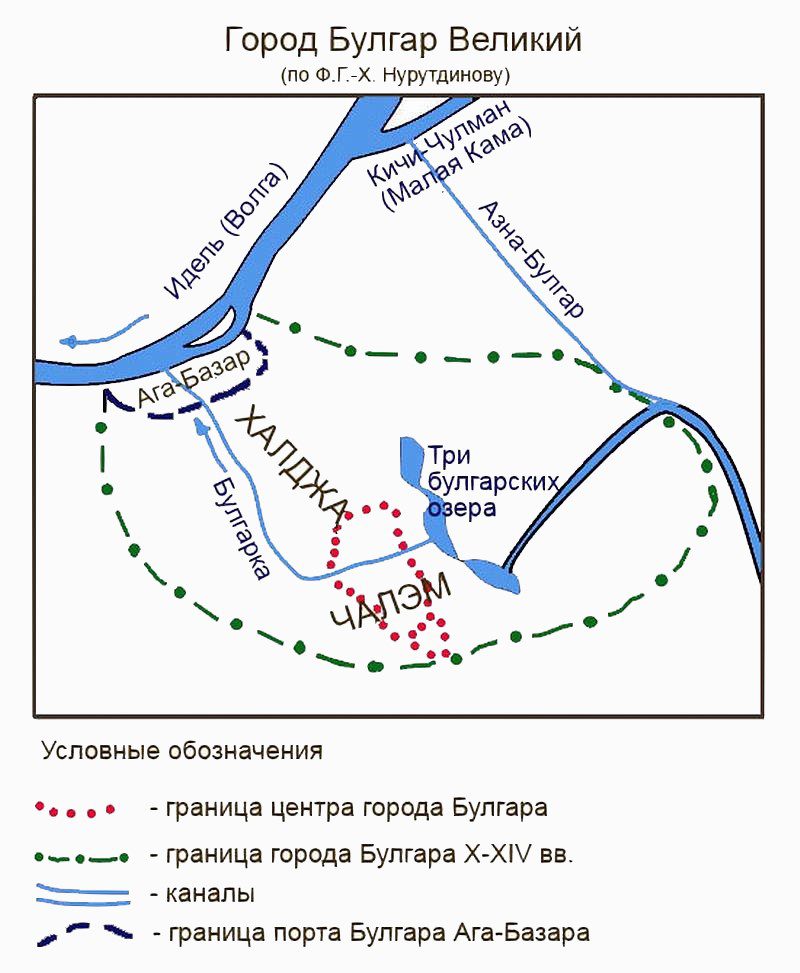
“Around this magnificent city of Bulgar, and its locals proudly also call “Alatura”, that is, “City of God”, the Aznak or Baznak steppe spreads, along the outskirts of which the river Ben-Azna (Abyss) flows ... The inhabitants of Bulgar, having built two canals a farsang and one and a half farsang long, connected Ben-Azna with two rivers and arranged a new channel of Ben-Azna - "Azna-Bulgar" and three lakes, from which the Mola-Bulgar (Bulgarka) river flows. At high water, small ships approach along the Molla-Bulgar from its port of Kichi Bulgar al-Kharij (“Little Outer Bulgar”) directly to the city center, from which the port is one farsang (6-7 km.). In width, as you can see, the city stretches for a farsang, and in length, along Itil (Volga) - for one and a half farsangs (about 10 km.) <…> The steppe reaches a width of five farsangs, and a length of 15 farsangs. In its fertile expanses, occupied by vast meadows with lush grass and marvelous flowers, water and air are exceptionally pleasant. But even more beautiful are the Bulgarian maidens, each of which is like the mistress of the world. But because of the long and harsh winters, the Bulgars wear so many different clothes and furs that both men and women look somewhat baggy.
Bulgar has been under the rule of Islam for a long time, and there are different in appearance and incomparable mosques - tongues cannot glorify, and feathers cannot describe them. They are decorated with multi-colored glass and scarves and, despite the massiveness of solid foundations, they are very slender and directed upwards with their minarets. So, the language of those who describe them will be weakened, and the pen will break due to the impossibility of conveying all their beauty ... It is especially difficult to describe the Ismaildan Cathedral Mosque and the Mohammed-Alam University, the main building of which is called Kazy Yorte (Palace of Justice) ). In total, there are 84 mosques in Bulgar, of which 7 belong to the Shiites, and the rest to the Sunnis. In addition, in Bulgar there are 6 thousand wooden and stone houses, half of which have at least two floors, 600 large workshops with adjoining shops, seven huge caravanserais, three public baths, not counting private ones, of which there are three thousand ...
At least 40 workshops manufacture and fire clay pipes, which are widely used in all cities of Bulgaria. Through one of these pipes, water is supplied to the houses of the Bulgars from special water towers, through others - the hot air of stoves, which warms the house in the cold ...
The inhabitants of Bulgar are fanatical in keeping city streets and squares clean: they are covered with stone slabs and are cleaned several times a day. All people, their animals, carts and things at the entrance to Bulgar are cleaned from road dust and dirt in special washing rooms at all entrances to the city. At the same time, there were 94 mosques in Bulyar, but there were as many Sunni mosques as in Bulgar... In addition to them, there are seven large caravanserais in Bulyar, three public baths, not counting private ones, and seven thousand wooden and stone houses...
The central walls of both Bulgar and Bulyar have 14 gates each. In Bulgar there is no single, common outer wall, and each quarter of the Outer City strengthens itself and according to its own taste, and in Bulyar, instead of the outer wall, there is a high earthen rampart with a palisade with 10 passages ... "
Bulgar, the holy house of Islam, is now turned into ruins.
It was erected on a marvelous place, it was visible from all sides,
He was proud of the mosques - only ruins remained of them.
- so wrote about the city of Bulgar another famous Bulgarian pilgrim - the great Bulgarian poet Gali Chokry (1826-1889).

